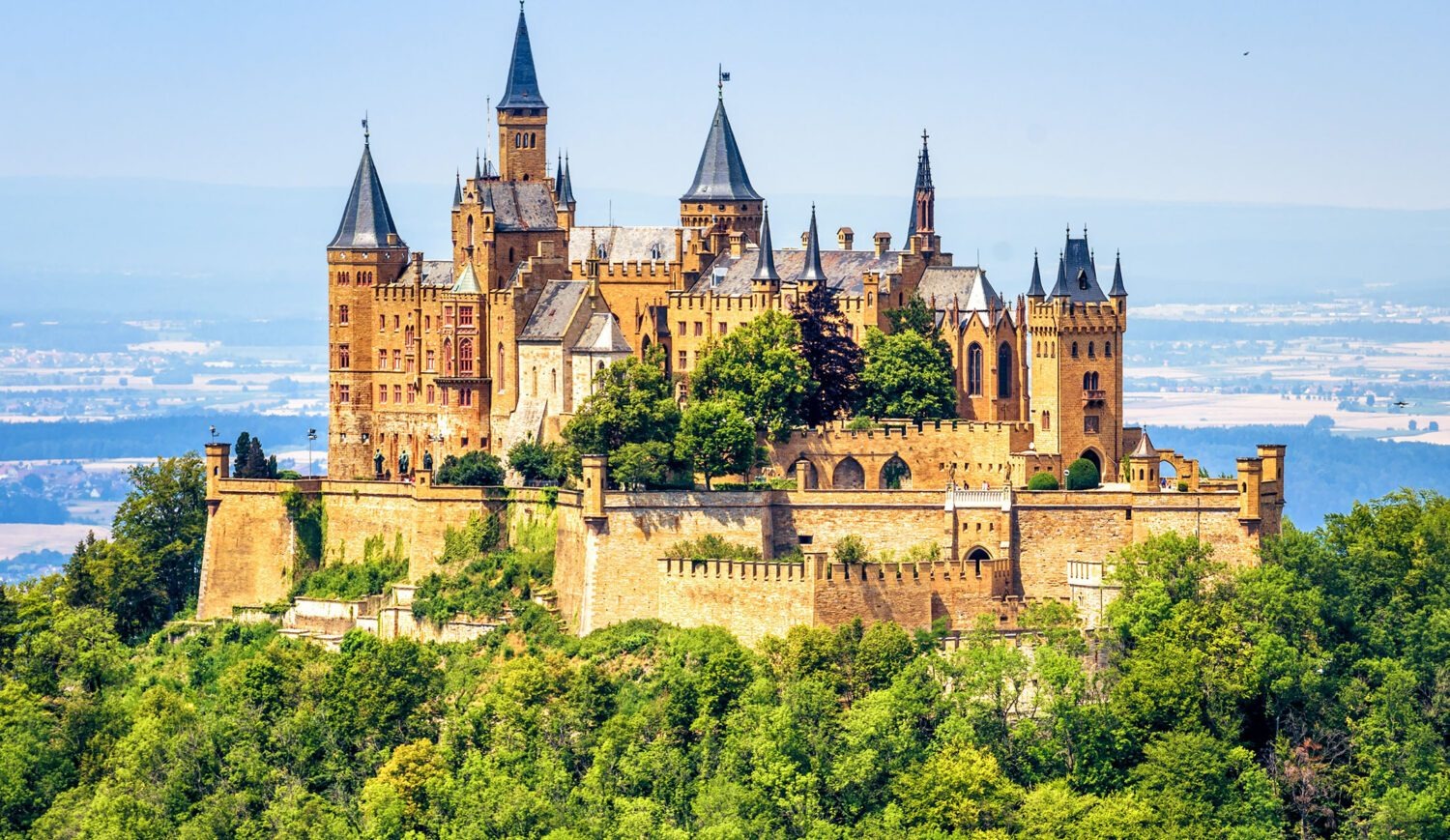Germany is a land of fairy-tale landscapes, winding rivers, and forests that seem pulled straight from old legends. Castles stand at the heart of this cultural tapestry – symbols of history, artistry, and power.
Some look like they were sketched by the Brothers Grimm, perched dramatically on cliffs or hidden deep in valleys. Others serve as reminders of dynastic ambitions and European conflicts.
For first-time travelers, castles in Germany are more than just photo opportunities – they’re windows into a layered past and places where atmosphere, architecture, and storytelling merge.
This guide walks you through the most beautiful castles to visit, blending history, atmosphere, and practical tips so you can experience them in a way that feels alive rather than like a checklist.
1. Neuschwanstein Castle – The Icon of Romance

Few places in Europe embody the idea of a “fairy-tale castle” as fully as Neuschwanstein.
Built by King Ludwig II in the 19th century, it was designed less as a fortress and more as a stage set for Wagnerian myths.
The white towers rising over the Bavarian Alps are as surreal in person as they are in postcards.
Inside, expect lavish interiors dripping with medieval-inspired fantasy. Practical note: tickets sell out quickly, especially in summer.
Booking online in advance is not optional—it’s essential. The walk up to the castle is steep, but shuttle buses and horse-drawn carriages are available.
2. Hohenzollern Castle – A Prussian Crown
Perched high on Mount Hohenzollern, this fortress reflects the might of the dynasty that would eventually shape the German Empire.
The approach is stunning—towers rising above forested hills, often shrouded in mist.
Unlike some castles that feel static, Hohenzollern hosts seasonal events, like open-air cinema nights and medieval markets. That sense of living tradition makes it more than a static monument.
3. Heidelberg Castle – A Romantic Ruin

Half-standing and half-fallen, Heidelberg Castle represents a different kind of beauty. Once the seat of the Palatinate electors, it was partly destroyed in the 17th century.
Today, ivy creeps through its ruins, making it one of the most atmospheric castle visits in Germany.
It overlooks Heidelberg’s Old Town and the Neckar River, providing one of the country’s most romantic views.
Consider riding the funicular railway up to the castle for less effort and more charm.
4. Nymphenburg Palace – Baroque Jewel
If you’re looking for a regal experience without leaving Munich, Nymphenburg Palace (Schloss Nymphenburg) is the perfect choice. Located in the city’s western district, this sprawling Baroque complex was once the summer residence of the Bavarian royal family, the Wittelsbach dynasty.
The palace itself stretches over 600 meters, making it one of the largest royal residences in Europe. Inside, you’ll find gilded halls, frescoed ceilings, and the famous Gallery of Beauties, where portraits commissioned by King Ludwig I showcase women from all social classes.
Each room reflects the evolution of taste from the Baroque through Rococo and into Neoclassicism.
But the real magic begins once you step outside. The palace gardens are vast and meticulously designed, blending formal French-style landscaping with later English influences.
As you wander, you’ll stumble upon several charming “park palaces” or pavilions, each with its own character:
- Amalienburg: A Rococo hunting lodge with one of the most stunning mirrored halls in Europe.
- Pagodenburg: Inspired by Chinese design, built for garden tea ceremonies.
- Badenburg: A bathhouse that once featured one of the earliest indoor heated pools.
- Magdalenenklause: A hermitage-like retreat designed to reflect simplicity and spirituality.
Visiting Nymphenburg can easily take half a day, and it offers a different kind of atmosphere than the fairy-tale castles perched on mountain cliffs.
Here, you sense courtly life, leisurely afternoons, and a touch of urban sophistication.
And when you’re in Munich and would like some company on your tour of the city and its history, services such as Louisa Escort can complement the experience—making your exploration of royal palaces and cultural landmarks feel both personal and memorable.
Practical tip: Nymphenburg is just a 15-minute tram ride from Munich’s center. To truly enjoy the palace and its gardens, give yourself at least three hours.
5. Wartburg Castle – Where History Changed

Wartburg is not only beautiful—it’s pivotal. This is where Martin Luther translated the New Testament into German while in hiding, forever shaping European history. The structure itself blends medieval foundations with Renaissance elements.
Walking through Wartburg feels less like touring and more like tracing footsteps that altered faith and culture. The castle’s art collections and preserved rooms highlight its dual role as fortress and cultural beacon.
6. Burg Eltz – A Castle in the Forest
Unlike many castles sitting atop exposed hills, Burg Eltz hides in a forested valley above the Moselle River. Its pointed towers and timbered walls look like something Tolkien would have imagined.
It’s been in the hands of the same family for over 800 years, making it one of Germany’s rare continuously inhabited castles.
Visitors can tour authentic interiors filled with medieval armor, tapestries, and family relics. Parking is about a 15-minute walk away, which means arriving early helps beat the crowds.
7. Sanssouci Palace – Rococo Splendor

Not a medieval fortress but a Rococo palace, Sanssouci in Potsdam represents another face of German castle culture. Built for Frederick the Great, it mirrors the elegance of Versailles on a smaller, more personal scale.
The terraced vineyards leading up to the palace create one of the most graceful approaches you’ll find anywhere. Inside, gilded halls and intimate rooms make it easy to picture Frederick debating philosophy with Voltaire.
8. Lichtenstein Castle – A Cliffside Marvel
Nicknamed the “fairy-tale castle of Württemberg,” Lichtenstein looks like it’s barely clinging to its cliffside perch. The neo-Gothic design makes it feel like something imagined rather than engineered.
Tours are short but rich in detail, focusing on weapons collections and medieval traditions. The castle also serves as a perfect photography stop for road trips through the Swabian Jura.
9. Marienburg Castle – Hanover’s Jewel

A lesser-known gem, Marienburg near Hanover was a birthday gift from King George V of Hanover to his wife. With turrets, Gothic spires, and bright sandstone walls, it feels almost too pretty to be real.
Unlike some larger castles, Marienburg offers a more intimate experience, with fewer crowds and a cozy, almost personal atmosphere. Guided tours add depth to its romantic origin story.
Final Thoughts
Germany’s castles are not just relics but living stories. Some dazzle with their architecture, others charm through their ruins, and a few still breathe with family life. Whether you’re in Bavaria, Saxony, or the Rhineland, each castle adds a layer of depth to a traveler’s journey.
Planning smart—booking tickets early, allowing time for hikes or funicular rides, and pairing each visit with a local meal or wine tasting—ensures the experience is more than sightseeing. It becomes cultural immersion.
Germany’s castles invite you to step into history, but they also meet you where you are today—ready to give you atmosphere, perspective, and a memory that lingers far beyond the walls.

